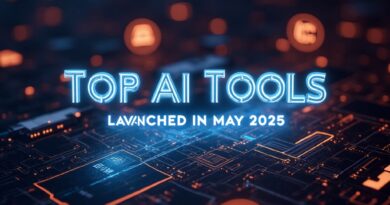Difference Between AI, ML, and DL – Explained for Beginners
🧠 Difference Between AI, Machine Learning (ML), and Deep Learning (DL) – Explained Simply
🤖 What is Artificial Intelligence (AI)?
Artificial Intelligence, or AI, is the broad science of mimicking human abilities using machines. It’s the umbrella term that covers all forms of smart automation, whether it’s a simple rule-based chatbot or a self-driving car.

💡 Technical Definition:
AI is a field of computer science that focuses on creating systems capable of performing tasks that typically require human intelligence, such as:
-
Reasoning
-
Learning
-
Problem-solving
-
Understanding language
-
Perception (e.g., vision, speech)
🛠️ Real-Life Examples of AI:
-
Siri and Alexa: These voice assistants can answer questions, control devices, and learn preferences.
-
Google Maps: AI is used to predict traffic and suggest the fastest route.
-
Netflix recommendations: Predicts what you might like based on your viewing history.
-
Self-driving cars: Tesla’s Autopilot uses AI to detect lanes, obstacles, and make driving decisions.
👉 Artificial Intelligence – IBM
🤓 What is Machine Learning (ML)?
Machine Learning is a subset of AI. It refers to systems that learn from data and improve over time without being explicitly programmed for every task.
💡 Technical Definition:
Machine learning is a method of data analysis that automates analytical model building. Using algorithms, ML systems learn patterns from historical data and apply what they’ve learned to new data.
🧪 How It Works:
-
Input data → Trained model → Output prediction
-
It uses training data to find patterns (like spam email detection).
-
Once trained, the model can make predictions on unseen data.
🛠️ Real-Life Examples of ML:
-
Spam filters: Gmail uses ML to classify emails as spam or not.
-
Credit scoring: Banks use ML to assess your credit risk.
-
Fraud detection: Detects unusual patterns in your bank account.
-
Personalized ads: Facebook and Google tailor ads based on your behavior.
🔍 Key ML Algorithms:
-
Linear Regression
-
Decision Trees
-
Random Forest
-
K-Nearest Neighbors
-
Support Vector Machines (SVM)
👉 Machine Learning Crash Course – Google
🧠 What is Deep Learning?
Deep Learning is a specialized branch of machine learning. It uses neural networks with multiple layers (hence “deep”) to model complex patterns in data.
💡 Technical Definition:
Deep Learning uses artificial neural networks, which are algorithms inspired by the structure and function of the human brain. These networks contain layers of nodes (neurons) that process data in a hierarchical manner.
🤖 How It Works:
-
A deep neural network may have hundreds of layers.
-
Each layer extracts features from the data, like detecting edges, shapes, or even objects in an image.
-
It is best suited for huge datasets and complex problems like image and speech recognition.
🛠️ Real-Life Examples of Deep Learning:
-
Facial recognition: Used in phones and security systems.
-
ChatGPT & GPT-4: These models use deep learning to generate human-like text.
-
Medical imaging: AI can detect tumors in X-rays or MRIs.
-
Language translation: Google Translate uses deep learning for real-time translations.
🌐 External Resource:
👉 What is Deep Learning? – NVIDIA
📊 Key Differences Between AI, Machine Learning, and Deep Learning
| Feature | Artificial Intelligence (AI) | Machine Learning (ML) | Deep Learning (DL) |
|---|---|---|---|
| Definition | Broad concept of machines being intelligent | Subset of AI that learns from data | Subset of ML using neural networks |
| Dependency | Can be rule-based or learning-based | Requires data for training | Requires large datasets and computational power |
| Human Intervention | May require manual coding | Limited intervention once trained | Minimal human intervention needed |
| Data Requirement | Varies | Moderate | High (Big Data) |
| Example | Smart assistant | Email spam filter | Self-driving car vision system |
Also Read,
How AI Is Transforming Everyday Life – Real Examples
How AI Is Transforming Education, Jobs & Career Growth in 2025
🎯 Use Cases Comparison
🧠 Artificial Intelligence:
-
Virtual assistants (e.g., Google Assistant)
-
Automated customer service
-
Game AI (e.g., in chess or Go)
📘 Machine Learning:
-
Price prediction in e-commerce
-
Sentiment analysis in reviews
-
Stock market trend analysis
🎥 Deep Learning:
-
Autonomous vehicles
-
Voice assistants (natural language processing)
-
AI art and image generation
🆕 Recent Examples (2024-2025)
-
OpenAI’s GPT-4: A prime example of deep learning, used in ChatGPT, capable of understanding and generating text in multiple languages.
-
Google Gemini AI: Uses deep learning to power advanced AI features in smartphones and search engines.
-
Tesla FSD (Full Self-Driving): Relies heavily on deep learning to process real-time visual data and make driving decisions.
-
Meta’s AI Image Generator: Leverages deep learning to create photo-realistic images based on text input.
🚀 From Beginner to Pro: Where to Start?
-
Understand the Basics:
-
Learn what AI, ML, and DL mean (this post is a good start!).
-
-
Take Free Courses:
-
Play with Tools:
-
Use tools like ChatGPT, DALL·E, and Teachable Machine to experiment.
-
-
Start Small Projects:
-
Predict movie ratings, classify emails, or detect images using open datasets.
-
-
Dive Deeper into Neural Networks:
-
Try TensorFlow, PyTorch, or Keras for practical coding experience.
-
🧠 Summary
| Term | Summary |
|---|---|
| AI | The broad science of making machines smart |
| ML | A subset of AI where machines learn from data |
| DL | A further subset of ML using neural networks for complex tasks |
Understanding the difference between AI, machine learning, and deep learning helps demystify much of the modern tech we use daily. Whether you’re just curious or planning a career in tech, knowing how these fields interact is a great step toward becoming future-ready.
📚 Final Thoughts
We’re living in the Age of AI, and the line between human and machine intelligence is blurring faster than ever. By understanding these concepts clearly, you’re better equipped to use, adapt, and even innovate with the tools of tomorrow.
If you’re starting your AI journey, remember: every pro was once a beginner. Start small, stay curious, and explore the world of smart machines! 🚀
📤 Stay Updated with NextGen Careers Hub
📱 Follow us on Instagram
📺 Subscribe us on YouTube
Please share our website with others: NextGenCareersHub.in






Comments are closed.